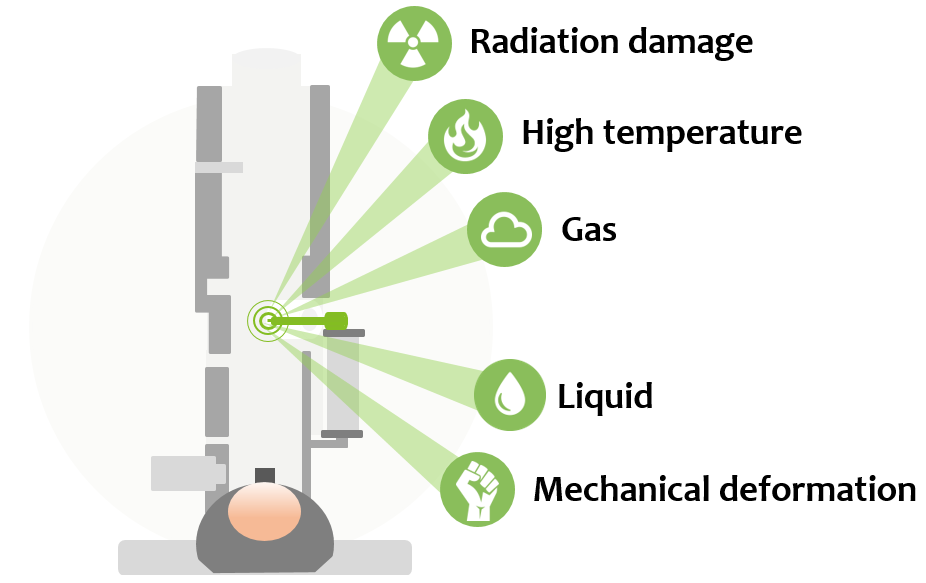The degradation of structural materials under harsh environments, such as high temperature, corrosion, radiation damage, and mechanical deformation, may lead to a series of problems impacting the society and economy. For example, rust induced by corrosion is one of the main causes of bridge accidents. For another example, the hydrogen generated by the water-side high-temperature oxidation of zirconium alloy led to the explosions in the Fukushima accident.
Understanding the fundamental mechanisms of materials’ degradation is vital for the development of more robust structural materials. The microstructures and defects in materials have a great impact on the performance of materials, while they are usually too small to be characterized by human eyes and optical microscopes. In-situ transmission electron microscopy (TEM) technique enables the direct observation of the evolution of microstructures and defects at a spatial resolution scaling from 0.1 nm to 10,000 nm, offering the opportunity to discover or validate the fundamental mechanisms of materials’ failure at the atomic or nanoscale.

Publications:
[7] One Dimensional Wormhole Corrosion in Metals, Yang Yang†, Weiyue Zhou†, Sheng Yin, Sarah Y. Wang, Qin Yu, Matthew J. Olszta, Ya-Qian Zhang, Steven E. Zeltmann, Mingda Li, Miaomiao Jin, Daniel K. Schreiber, Jim Ciston, M. C. Scott, John R. Scully, Robert O. Ritchie, Mark Asta, Ju Li, Michael P. Short, Andrew M. Minor, Nature Communications, (2023), 14, 988.
[6] Evaluating the effects of pillar shape and gallium ion beam damage on the mechanical properties of single crystal aluminum nanopillars, Yang Yang†, Sarah Y. Wang†, Bin Xiang, Sheng Yin, Thomas C. Pekin, Xiaoqing Li, Ruopeng Zhang, Kayla Yano, David Hwang, Mark Asta, Costas Grigoropoulos, Frances I. Allen, and Andrew M. Minor, Journal of Materials Research, (2021).
[5] Achieving large uniform tensile elasticity in microfabricated diamond, Chaoqun Dang†, Jyh-Pin Chou†, Bing Dai†, Chang-Ti Chou†, Yang Yang, Rong Fan, Weitong Lin, Fanling Meng, Alice Hu, Jiaqi Zhu, Jiecai Han, Andrew M. Minor, Ju Li, Yang Lu, Science 371, 76–78 (2021)
[4] Carbon nanotube (CNT) metal composites exhibit greatly reduced radiation damage, Kang Pyo So†, Penghui Cao†, Yang Yang, Jong Gil Park, Mingda Li, Long Yan, Jing Hu, Mark Kirk, Meimei Li, Young Hee Lee, Michael P.Short, Ju Li, Acta Materialia, 2020
[3] Atomic-scale phase separation induced clustering of solute atoms, Lianfeng Zou†, Penghui Cao†, Yinkai Lei†, Dmitri Zakharov, Xianhu Sun, Stephen D. House, Langli Luo, Jonathan Li, Yang Yang, Qiyue Yin, Xiaobo Chen, Chaoran Li, Hailang Qin, Eric A. Stach, Judith C. Yang, Guofeng Wang & Guangwen Zhou, Nat Commun 11, 3934 (2020)
[2] Liquid-Like, Self-Healing Aluminum Oxide during Deformation at Room Temperature, Yang Yang, Akihiro Kushima, Weizhong Han, Huolin Xin and Ju Li, Nano Letters 18 (2018) 2492-2497.
[1] Bimetallic nanoparticle oxidation in three dimensions by chemically sensitive electron tomography and in situ transmission electron microscopy, Weiwei Xia, Yang Yang, Qingping Meng, Zhiping Deng, Mingxing Gong, Jie Wang, Deli Wang, Yimei Zhu, Litao Sun, Feng Xu, Ju Li and Huolin Xin, ACS Nano, (2018) 12, 7866-7874.